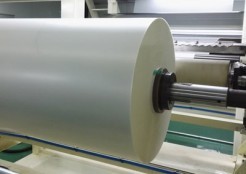Informations
PE (Polyethylene) protective films are
widely used in various industries to safeguard surfaces from scratches, dust,
dirt, and other damages during transportation, storage, or installation
processes. One critical aspect of PE protective films is the printing method
used to apply logos, instructions, or other information on the film's surface.
In this essay, we will explore the differences between surface printing and
inside printing of PE protective films and their impact on film customization
and applications.
Surface printing is the most common method
used for printing PE protective films. It involves applying ink directly onto
the top surface of the film, which is then dried or cured to form a durable
printed layer. Surface printed films offer several benefits, including high
visibility of the printed content, excellent color vibrancy, and the ability to
print complex designs and images. This makes surface printed films ideal for
applications where the printed information needs to be clearly visible, such as
in advertising, branding, or instructional films.
On the other hand, inside printing is a
relatively newer method that involves printing the ink on the adhesive side of
the film, which is then covered with a clear or translucent protective layer.
The printed content is viewed through the film, giving it a unique
"inside" appearance. Inside printed films offer advantages such as
increased durability of the printed layer, enhanced resistance to abrasion or
chemicals, and improved tamper-proof properties. Inside printing is often used
in applications where the printed information needs to be protected from wear
and tear or harsh environments, such as in automotive, electronics, or
industrial films.
One of the key differences between surface
printing and inside printing is the visibility of the printed content. Surface
printed films offer a higher level of visibility, as the ink is applied
directly on the top surface of the film, making it more prominent and easily
readable. Inside printed films, on the other hand, may have a slightly subdued
appearance due to the clear or translucent protective layer covering the
printed content. However, this can also be advantageous in applications where a
subtle or sophisticated appearance is desired.
Another difference is the durability of the
printed layer. Surface printed films may be more susceptible to wear and tear,
as the ink is exposed to external elements and can be scratched or damaged over
time. Inside printed films, on the other hand, have the printed layer protected
by the clear or translucent layer, making it more resistant to abrasion,
chemicals, or other environmental factors. This can be beneficial in
applications where the protective film needs to maintain its appearance and
functionality for an extended period.
Film customization is also impacted by the
printing method used. Surface printing allows for greater flexibility in terms
of design options, as it can accommodate a wide range of colors, graphics, and
images. Inside printing, on the other hand, may have limitations in terms of
color vibrancy and design complexity, as the printed content is viewed through
the film. However, advancements in printing technology have enabled inside
printing to offer a wider range of customization options, including multi-color
printing and intricate designs.
In conclusion, understanding the
differences between surface printing and inside printing of PE protective films
is crucial in choosing the right printing method for specific applications.
Surface printing offers high visibility and versatility in design options,
making it suitable for applications where clear and vibrant printed content is
desired. Inside printing offers increased durability and protection for the
printed layer, making it ideal for applications where durability and resistance
to wear and tear are important. Consideration of the visibility of printed
content, durability, and customization requirements is essential in selecting
the most appropriate printing method for PE protective films.





